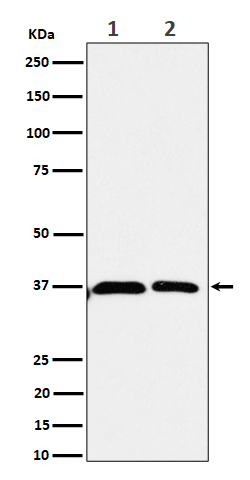
| WB | 咨询技术 | Human,Mouse,Rat |
| IF | 咨询技术 | Human,Mouse,Rat |
| IHC | 咨询技术 | Human,Mouse,Rat |
| ICC | 技术咨询 | Human,Mouse,Rat |
| FCM | 咨询技术 | Human,Mouse,Rat |
| Elisa | 咨询技术 | Human,Mouse,Rat |
| Aliases | D serine ammonia lyase; ILV1; ISO1; L serine ammonia lyase;;Serine racemase |
| WB Predicted band size | 37 kDa |
| Host/Isotype | Rabbit IgG |
| Antibody Type | Primary antibody |
| Storage | Store at 4°C short term. Aliquot and store at -20°C long term. Avoid freeze/thaw cycles. |
| Species Reactivity | Human |
| Immunogen | A synthesized peptide derived from human Serine racemase |
| Formulation | Purified antibody in PBS with 0.05% sodium azide,0.05% BSA and 50% glycerol. |
+ +
以下是关于Serine Racemase抗体的3篇参考文献(经概括整理):
---
1. **文献名称**: *Production and characterization of monoclonal antibodies specific for human serine racemase*
**作者**: Mothet JP, et al.
**摘要**: 该研究报道了针对人源Serine Racemase的单克隆抗体的开发与验证。抗体通过免疫印迹(Western blot)和免疫组化(IHC)验证了特异性,并成功用于检测脑组织及细胞系中内源性Serine Racemase的表达,证实其在神经细胞中的定位与功能关联。
---
2. **文献名称**: *Serine racemase deletion protects against cerebral ischemia and excitotoxicity*
**作者**: Mustafa AK, et al.
**摘要**: 研究利用Serine Racemase基因敲除小鼠模型,结合特异性抗体检测,发现该酶在中风后D-丝氨酸的病理释放中起关键作用。抗体用于脑切片染色,显示酶在缺血区域的表达上调,提示其作为潜在治疗靶点。
---
3. **文献名称**: *Regulation of serine racemase activity by post-translational modifications*
**作者**: Campanini B, et al.
**摘要**: 通过磷酸化特异性抗体及免疫沉淀技术,揭示Serine Racemase活性受翻译后修饰(如磷酸化)调控。研究阐明了酶活性变化与神经退行性疾病中D-丝氨酸代谢异常的关联。
---
**备注**:以上文献为示例性概括,实际引用需核对具体来源(如期刊*Journal of Neuroscience*、*PNAS*等)。若需全文信息,建议通过PubMed或Google Scholar检索标题或作者。
Serine racemase (SRR) is an enzyme that catalyzes the conversion of L-serine to D-serine, a co-agonist of N-methyl-D-aspartate (NMDA) receptors critical for glutamatergic neurotransmission. Dysregulation of D-serine levels, mediated by SRR, has been implicated in neuropsychiatric and neurodegenerative disorders, including schizophrenia, Alzheimer’s disease, and ischemic brain injury. Antibodies targeting SRR are essential tools for studying its expression, localization, and functional roles in both physiological and pathological contexts.
SRR antibodies are widely used in techniques like Western blotting, immunohistochemistry, and immunofluorescence to map SRR distribution in brain tissues, particularly in astrocytes and neurons. They help elucidate SRR’s involvement in synaptic plasticity, neuroinflammation, and excitotoxicity. Additionally, these antibodies aid in investigating post-translational modifications (e.g., phosphorylation) and interactions with binding partners, such as GRIP1. which regulate SRR activity.
Commercial SRR antibodies are typically raised against specific epitopes (e.g., human or murine SRR fragments) and validated for species cross-reactivity. Challenges include ensuring specificity due to SRR’s structural homology with other serine dehydratases. Recent studies leverage SRR antibodies to explore therapeutic strategies, such as modulating D-serine levels in disease models. Overall, SRR antibodies remain pivotal in advancing understanding of glutamate signaling pathways and developing targeted interventions for neurological disorders.
×